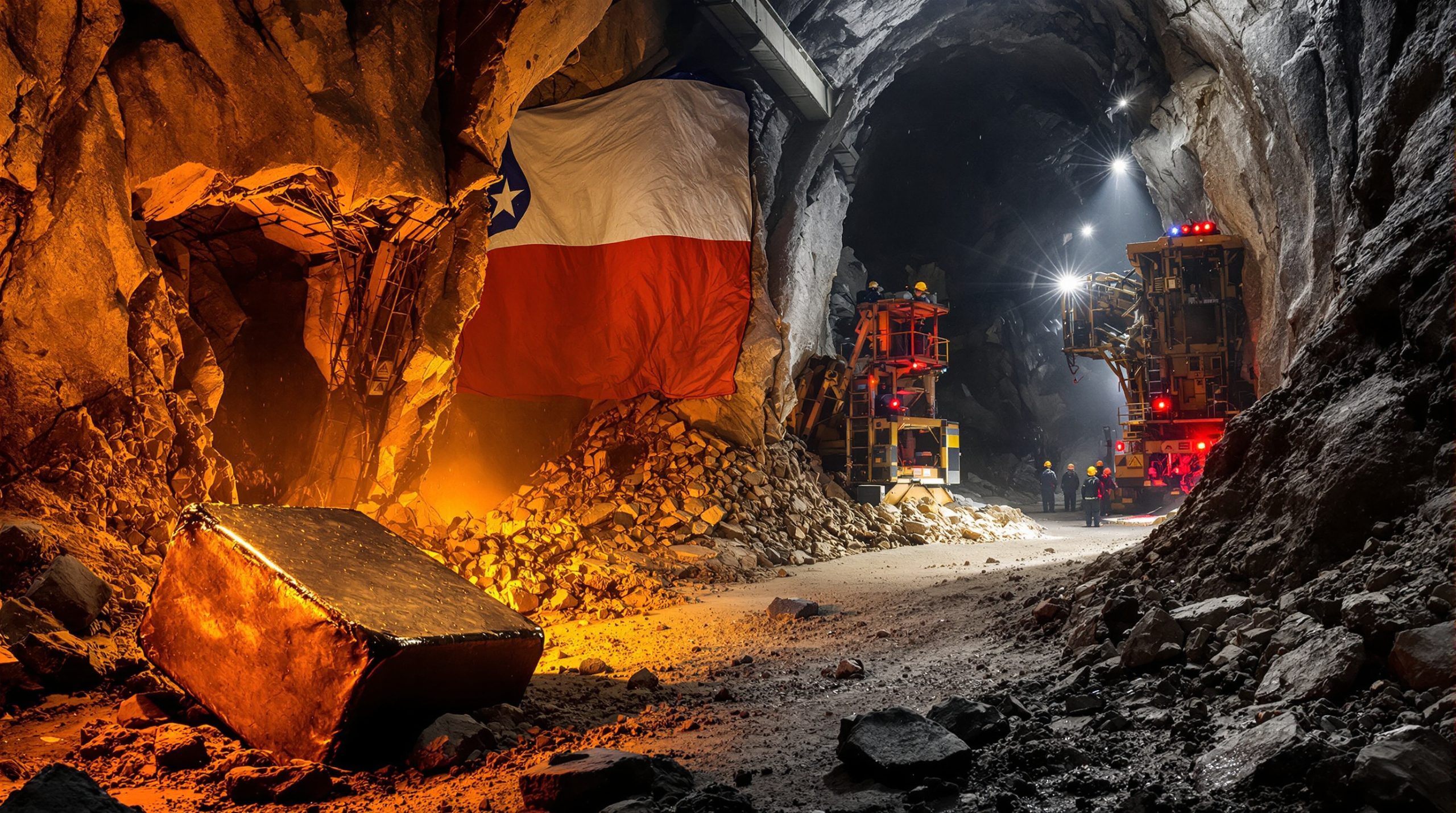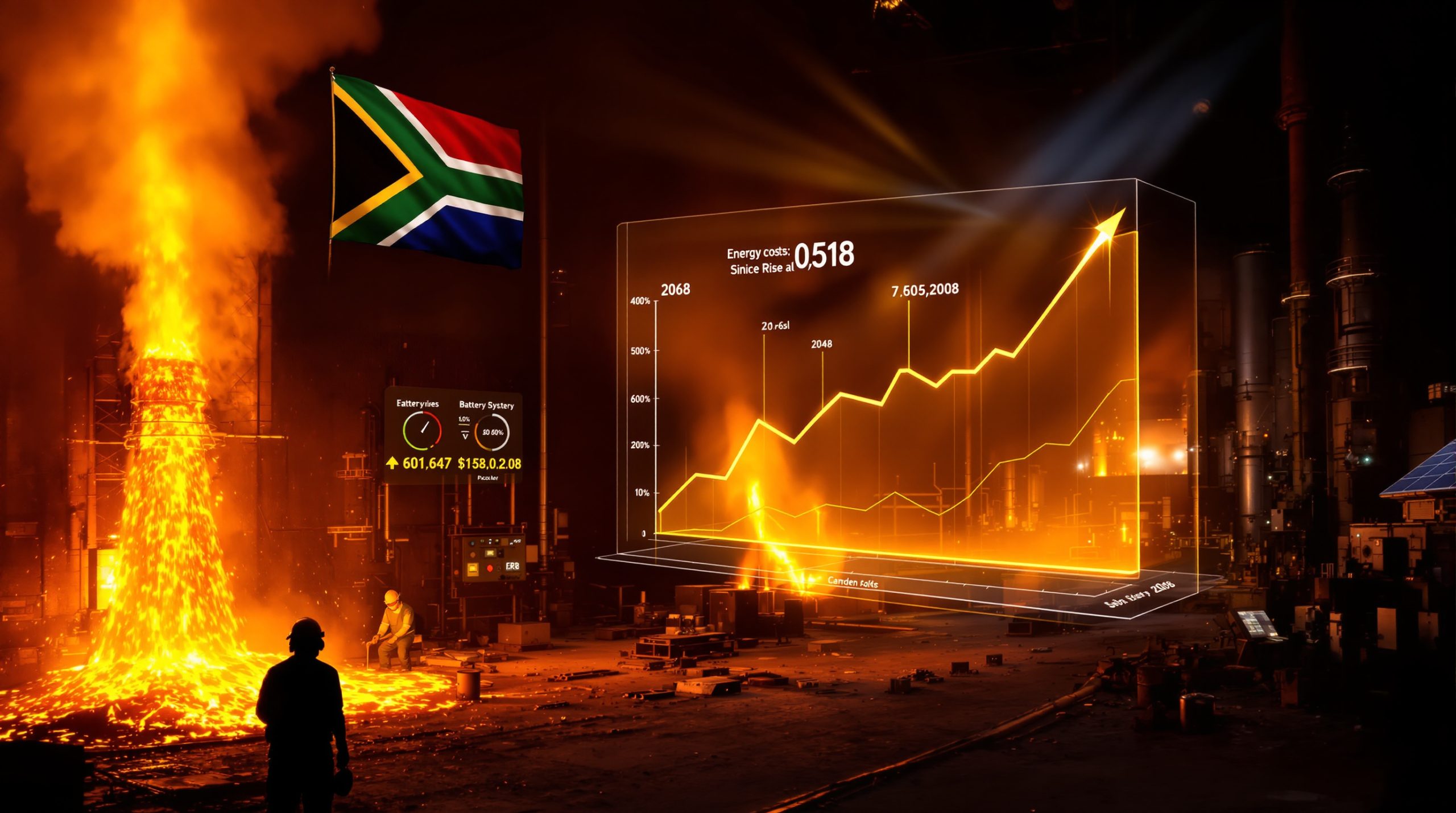Why Is Global Copper Supply Facing Unprecedented Risks?
The copper market is at a critical juncture in 2025, with multiple supply disruptions threatening to derail metal availability crucial for the clean energy transition and industrial growth. Recent price surges to 16-month highs reflect growing concerns about copper's future availability. BHP forecasts demand to increase from the current 33 million tonnes annually to 50 million tonnes by 2050, while US Geological Survey data indicates supply must at least double to prevent a severe shortage.
What was expected to be a balanced market has transformed into a potential deficit due to multiple high-impact disruptions at major copper mines. These operational challenges, combined with declining ore grades, climate impacts, and geopolitical tensions, create a perfect storm threatening global copper supply at risk.
The price of copper reached a 16-month high of $5.123/lb in October 2025, signaling market recognition of these growing supply risks. Analysts note that without significant new production coming online, the market could face persistent deficits through the remainder of the decade.
Critical Supply-Demand Imbalance
The copper market is projected to require at least one million additional tonnes annually to meet growing demand from electrification, renewable energy deployment, and industrial expansion. This surging copper demand comes at a time when bringing new mines online typically requires 15-20 years from discovery to production.
Market factors exacerbating the supply risk include:
- Declining ore grades at existing mines requiring more material to be processed for the same metal output
- Increasing depth of mining operations raising costs and complexity
- Growing water scarcity in key producing regions like Chile and Peru
- Heightened permit requirements delaying new project development
- Rising capital intensity for new projects deterring investment
These supply challenges coincide with accelerating demand from the clean energy transition, electric vehicle manufacturing, and grid modernization efforts worldwide.
What Major Mine Disruptions Are Impacting Global Copper Supply?
Grasberg Landslide Crisis
Indonesia's Grasberg mine, the world's second-largest copper producer, suspended operations on September 8, 2025, following a catastrophic landslide that unleashed 800,000 tonnes of mud, trapping seven workers. This shutdown at a facility that produced nearly 297,103 tonnes in the first half of 2025 has prompted Goldman Sachs to revise global copper supply forecasts downward for both 2025 and 2026.
The landslide represents the most significant disruption at Grasberg since its transition from open-pit to underground operations. Recovery efforts remain ongoing, with production restart timelines still uncertain. Each month of closure represents approximately 50,000 tonnes of lost production capacity.
Kamoa-Kakula Flooding Incident
The Kamoa-Kakula complex in the Democratic Republic of Congo, which produced 245,129 tonnes in H1 2025, halted operations for three weeks following seismic activity on May 18 that severely flooded underground workings. This disruption forced operator Ivanhoe Mines to revise production guidance downward.
The flooding incident highlights the vulnerability of even modern mining operations to geological and environmental risks. While operations have resumed, the company continues to implement enhanced water management systems to prevent future disruptions.
El Teniente Earthquake Damage
Chile's El Teniente, the world's largest underground copper mine, lost between 20,000 to 30,000 metric tons of production following a collapse triggered by a 4.2-magnitude earthquake in late July 2025. Despite this setback, the mine still produced 172,000 tonnes in the first half of 2025.
The earthquake damage underscores the geological risks facing underground mining operations, particularly in seismically active regions like Chile. Recovery efforts have focused on stabilizing affected tunnels and reinforcing other vulnerable areas.
Quebrada Blanca Operational Challenges
Teck Resources slashed its copper guidance due to persistent setbacks at its Quebrada Blanca operation in Chile, which produced 95,000 tonnes in H1 2025. The company announced it was deferring major expansion projects while working to resolve ongoing operational issues.
These operational challenges have been particularly disappointing given the significant capital investment in the Quebrada Blanca Phase 2 expansion. Technical difficulties with processing equipment and ramp-up delays have prevented the operation from reaching designed capacity.
How Are Labor Disputes Threatening Production Stability?
Los Pelambres Strike Potential
In September 2025, supervisors at Antofagasta's Los Pelambres mine in Chile rejected a contract offer, raising the possibility of a strike if further negotiations fail. The mine produced 143,200 tonnes in the first half of 2025, making any work stoppage significant for global supply.
Labor negotiations at Los Pelambres are particularly important as they could establish patterns for other upcoming contract negotiations in Chile's copper sector. A prolonged strike could remove approximately 24,000 tonnes of copper per month from global markets.
Strategic Labor Agreements
Several major producers have worked to secure labor stability through new agreements. Codelco signed new three-year collective labor contracts with unions at both Radomiro Tomic and Chuquicamata mines in Chile, ending recurring disputes that had previously threatened production.
These proactive labor agreements reflect the industry's growing recognition of workforce issues as a key risk factor in maintaining reliable copper supply. Stable labor relations are becoming increasingly important as technical skills shortages also affect the sector.
Wage Pressure and Productivity Challenges
Rising inflation and cost of living pressures are driving increased wage demands across the copper mining sector. Producers must balance competitive compensation with maintaining cost control, especially as ore grades decline and processing costs increase.
Mining companies are investing in automation and digitalization to improve productivity while addressing labor concerns. These technologies help mitigate safety risks while potentially reducing labor requirements for certain roles.
What Are The World's Top Copper Producers in 2025?
Top 5 Copper Mines by H1 2025 Production
-
Escondida (Chile): 680,500 tonnes
Jointly owned by BHP (57.5%), Rio Tinto (30%), JECO Corporation (10%), and JECO2 Ltd (2.5%), Escondida maintains its position as the world's largest copper mine. However, the proposed $53 billion merger between Anglo American and Teck Resources could create a copper complex that might eventually challenge Escondida's dominance.
-
Grasberg (Indonesia): 297,103 tonnes
The joint venture between Freeport-McMoRan (48.8%) and Indonesian state-owned Persero (51.2%) remains a critical global supplier despite its current operational suspension following the September landslide.
-
Kamoa-Kakula (DRC): 245,129 tonnes
This relatively new operation owned by Ivanhoe Mines (39.6%), Zijin Mining (39.6%), Crystal River Global Limited (0.8%), and the DRC government (20%) has quickly established itself as a top-tier producer despite recent flooding challenges.
-
Buenavista (Mexico): 207,473 tonnes
Owned by Southern Copper, this operation has maintained continuous production since 1899 and remains Mexico's largest copper producer. Located just 22 miles south of the US border, it benefits from strategic positioning for North American markets.
-
Cerro Verde (Peru): 193,320 tonnes
This joint venture between Freeport-McMoRan (53.56%), SMM Cerro Verde Netherlands (21%), Compañía de Minas Buenaventura (19.58%), and other shareholders (5.86%) continues as Peru's largest copper operation. The Peruvian government first mined Cerro Verde's oxide ores and built one of the world's first SX/EW facilities in 1972.
Notable Production Shifts in H1 2025
The remaining top 10 producers include Collahuasi (Chile) at 189,600 tonnes, El Teniente (Chile) at 172,000 tonnes, Quellaveco (Peru) at 156,600 tonnes, Antamina (Peru) at 154,369 tonnes, and Morenci (USA) at 152,458 tonnes.
Several operations narrowly missed the top 20 list, including First Quantum's Trident-Sentinel (89,469 tonnes) and Kansanshi (86,647 tonnes) mines, Western Mining's Yulong operation (83,412 tonnes), Southern Copper's Cuajone mine (81,738 tonnes), Anglo American's Los Bronces (80,300 tonnes), and KGHM's Sierra Gorda (77,111 tonnes).
Production Concentration and Geopolitical Risk
The global copper production outlook remains heavily concentrated in a few countries, with Chile and Peru accounting for approximately 40% of global mined output. This concentration creates vulnerability to regional events such as political changes, regulatory shifts, or environmental incidents.
The rise of the Democratic Republic of Congo as a major copper producer adds a new dimension to global supply dynamics, but also introduces additional geopolitical risk considerations given the country's history of political instability and infrastructure challenges.
How Are ESG Factors Constraining Copper Supply Growth?
Environmental, social, and governance (ESG) challenges are increasingly impacting copper supply chains. Over 25% of global copper supply is currently trapped by ESG roadblocks, with major reserves in the US, Peru, Chile, and Panama facing development delays or cancellations due to environmental concerns, community opposition, or governance issues.
These constraints come at a critical time when new projects are desperately needed to meet growing demand. The US Geological Survey data indicates that supply must at least double to avoid a severe shortage, yet bringing new mines online typically requires 15-20 years from discovery to production.
Water Management Challenges
Water scarcity represents one of the most significant ESG constraints for copper production, particularly in arid regions like northern Chile and southern Peru where many major mines operate. Companies are investing heavily in desalination plants and water recycling systems, but these add substantial capital and operating costs.
For example, BHP's Escondida mine in Chile relies on a desalination plant that cost over $3 billion to build. This investment was necessary to secure water supply but adds to production costs that must be absorbed or passed on to consumers.
Community Relations and Social License
Local community opposition has delayed or halted several significant copper projects globally. Gaining and maintaining social license to operate requires increasingly sophisticated stakeholder engagement, benefit-sharing arrangements, and transparent environmental management.
Projects facing community opposition often experience lengthy permitting delays, legal challenges, and in some cases, complete cancellation despite significant resource potential. This dynamic has become a major factor in investment decision-making for mining companies.
Carbon Footprint Reduction Efforts
The carbon intensity of copper production is receiving greater scrutiny from investors, customers, and regulators. Mining companies are investing in renewable energy, electrification of mining fleets, and process efficiency improvements to reduce emissions.
While these investments align with climate goals and can reduce long-term operating costs, they require significant upfront capital that can delay project development and reduce the pool of economically viable resources.
What Expansion Projects Could Alleviate Supply Concerns?
Olympic Dam Growth Initiative
BHP recently invested more than A$840 million ($555 million) in its Olympic Dam copper, gold, and uranium complex in South Australia, advancing growth projects ahead of a multibillion-dollar expansion decision expected in 2028. The mine produced 117,000 tonnes in H1 2025.
This investment focuses on increasing processing capacity and improving recovery rates from the complex polymetallic ore body. The larger expansion decision in 2028 could potentially double the operation's output if approved.
Quellaveco Upgrade Plans
Anglo American announced plans for an almost $26 million upgrade at its Quellaveco operation in Peru, which produced 156,600 tonnes in H1 2025. This investment aims to optimize production efficiency and potentially increase output.
Quellaveco represents one of the most significant new copper operations to come online in recent years. The announced upgrades will help address initial ramp-up challenges and improve the mine's contribution to global copper supply.
Antamina Production Boost
Operators of the Antamina mine in Peru are forecasting an almost 20% increase in copper output for 2026. The mine, co-owned by BHP, Glencore, Teck, and Mitsubishi, produced 154,369 tonnes in H1 2025.
This production increase will come from accessing higher-grade ore zones within the existing pit design. The improvement highlights how mine sequencing and grade management can impact medium-term supply even without major capital investments.
Oyu Tolgoi Ramp-Up
Rio Tinto confirmed that the production ramp-up at Mongolia's Oyu Tolgoi remains on track to deliver an average of around 500,000 tonnes of copper annually from 2028 to 2036, significantly above its current output of 152,000 tonnes in H1 2025.
The underground expansion at Oyu Tolgoi represents one of the most significant copper growth projects globally. When fully ramped up, it will become one of the world's largest copper operations, though technical challenges with the underground development have caused delays from the original schedule.
Brownfield Expansion Potential
While greenfield projects face significant hurdles, brownfield expansions at existing operations offer more immediate supply growth potential. These projects typically face fewer permitting obstacles, leverage existing infrastructure, and can be completed with shorter timelines.
Several major producers are evaluating brownfield expansion options that collectively could add 1-2 million tonnes of annual production capacity over the next five years, helping to offset some of the projected supply gap.
What Is The Outlook For Global Copper Supply?
The copper market faces significant challenges in meeting projected demand growth. BHP forecasts demand to increase by at least one million tonnes annually, rising from the current 33 million tonnes to 50 million tonnes by 2050. This growth is driven primarily by electrification, renewable energy deployment, and industrial expansion.
However, supply growth remains constrained by:
-
Declining ore grades at existing operations requiring more material to be processed for the same metal output
-
Operational disruptions from natural disasters and technical challenges as mines become deeper and more complex
-
Labor disputes threatening production stability, particularly in regions with rising inflation and cost pressures
-
ESG barriers delaying or preventing new project development as environmental and social standards increase
-
Extended development timelines for new mines stretching to 15-20 years from discovery to production
-
Geopolitical tensions affecting trade flows and investment in key producing regions
These factors collectively suggest that copper prices may remain elevated as the market adjusts to these supply constraints. Copper price predictions indicate producers with stable operations and expansion potential are likely to benefit from this market dynamic, while consumers may face higher costs and potential supply chain disruptions.
Supply Gap Projections
Most industry analysts project a growing supply gap emerging in the copper market from 2026 onward. Conservative estimates suggest a deficit of 1-2 million tonnes annually by 2030, while more aggressive forecasts indicate potential shortfalls of 4-6 million tonnes by the end of the decade.
This supply gap is expected to persist despite higher prices incentivizing new production, due to the long lead times required to bring new mines online and the increasing challenges associated with mine development.
Secondary Supply Contribution
Recycling and secondary production will play an increasingly important role in meeting copper demand. Currently, about 30% of global copper supply comes from recycled sources, but this percentage could increase with improved collection systems and technological advances in processing.
However, even with ambitious growth in recycling rates, secondary supply alone cannot address the projected supply gap, particularly as much of the copper currently in use will remain in service for decades.
How Can Stakeholders Navigate The Copper Supply Challenges?
For Investors
-
Monitor labor negotiations at major mines, particularly in Chile and Peru where contract renewals could impact significant production volumes
-
Track expansion projects that could alleviate supply constraints, focusing on those with shorter time-to-market and lower technical risk
-
Consider exposure to producers with stable jurisdictions and strong ESG credentials to minimize disruption risk
-
Watch for merger and acquisition activity that could reshape the producer landscape as companies seek to secure growth pipelines
-
Evaluate downstream fabrication and recycling operations that may benefit from higher primary copper prices
For Consumers
-
Develop diversified supply chains to mitigate regional disruption risks, including a mix of long-term contracts and spot market purchases
-
Consider long-term supply agreements to secure volume and potentially reduce price volatility exposure
-
Explore recycling opportunities to reduce primary copper dependence and potentially lower overall material costs
-
Monitor technological developments that could improve copper utilization efficiency or enable substitution in non-critical applications
-
Evaluate vertical integration strategies to secure critical raw material supplies
For Policymakers
-
Streamline permitting processes while maintaining environmental standards to reduce project development timelines
-
Develop strategic reserves to buffer against supply shocks, particularly for industries deemed critical to national security or economic stability
-
Invest in recycling infrastructure to increase secondary supply and reduce reliance on new mining projects
-
Support research into alternative materials for non-critical applications to reduce demand pressure on limited copper supplies
-
Develop international cooperation frameworks to ensure resource security amid growing geopolitical tensions
Risk Management Strategies
Effective risk management in the copper supply chain requires a multi-faceted approach combining:
-
Geographic diversification of supply sources to minimize regional disruption impacts
-
Contract structures that balance price exposure and supply security
-
Technology investment to improve material efficiency and enable substitution where feasible
-
Strategic partnerships with reliable producers committed to responsible production practices
-
Financial hedging to manage price volatility during periods of market imbalance
Conclusion
The global copper supply at risk faces unprecedented challenges in 2025, with major mine disruptions, labor tensions, and ESG constraints threatening availability just as demand accelerates. The combination of these factors has transformed market expectations from surplus to potential deficit, driving prices to multi-year highs.
While expansion projects at operations like Olympic Dam, Quellaveco, and Oyu Tolgoi offer some relief, they cannot fully offset the impact of major disruptions at Grasberg, Kamoa-Kakula, and other key producers. The market's ability to navigate these challenges will depend on operational stability at existing mines, successful development of new projects, and innovative approaches to recycling and material efficiency.
As the energy transition accelerates and industrial demand grows, copper's strategic importance will only increase, making supply security a critical concern for industries ranging from electric vehicles to renewable energy to construction. The coming years will likely see continued volatility as the market adjusts to these new realities.
The current supply challenges present both significant risks and opportunities for stakeholders across the copper value chain. Those who develop effective strategies to navigate these dynamics will be better positioned to manage costs, ensure supply security, and capitalize on the metal's crucial role in the global economy and energy transition.
Further Exploration
Readers interested in learning more about global copper supply dynamics can also explore related educational content, such as the UN report on climate risks to copper supply chains and the impact of US tariffs' impact on copper prices. These resources offer additional perspective on major copper producers and their production challenges.
Understanding the interplay between technical mining challenges, geopolitical factors, and market dynamics will be crucial for anyone involved in industries reliant on stable copper supplies. As the market navigates these complex challenges, staying informed about production developments, technological innovations, and policy changes will be essential for effective decision-making.
Furthermore, investors should carefully consider copper investment trends when building their portfolios, as the metal's critical role in the energy transition makes it a strategic commodity for the coming decades.
Ready to Spot the Next Major Copper Discovery?
Stay ahead of the market with Discovery Alert's proprietary Discovery IQ model, delivering real-time notifications when significant copper discoveries are announced on the ASX. Visit our discoveries page to understand how early identification of mineral discoveries can lead to exceptional investment returns, and start your 30-day free trial today.




